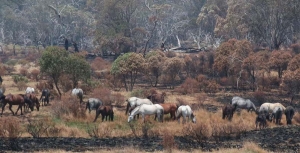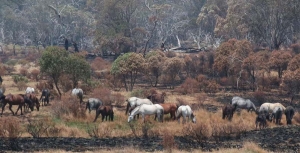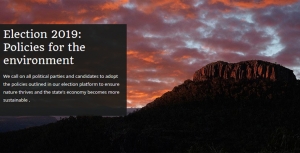Displaying items by tag: Feral Horses
Good news on effective control of feral horse numbers
In the previous edition of STEP Matters there was an article about the NSW government’s proposal and consultation on reinstating aerial culling of feral horses in Kosciuszko National Park. In October there was the pleasing announcement that the ridiculous decades-old ban on aerial shooting of feral horses is to be repealed. The latest government survey of horse numbers has actually shown a small decrease of about 7%. There is a long way to go to get down to the target of about 3,000 from the current estimate of about 17,000 horses.
This decision throws a lifeline to more than 30 endangered species that call the Australian Alps home, including the southern corroboree frog and mountain pygmy possum. Our park rangers can now finally get on with the task of removing thousands of feral horses from our fragile alpine environments – before the mountains and rivers are trampled beyond repair.
Feral horses in Kosciuszko
Finally there is the prospect of real action on feral horses in Kosciuszko National Park – please make a submission by 11 September 2023.
Penny Sharpe, NSW Environment Minister has announced a proposal to amend the Kosciuszko Wild Horse Management Plan to permit aerial culling of feral horses. There is an urgent need for action as the number of horses has been increasing rapidly. The government says the most recent official count estimate was that there are between 14,501 and 23,535 feral horses across the park.
Under the management plan agreed to under the previous government, the number of horses had to be reduced to 3,000 by 2027 in order to limit the damage they are doing to the sensitive alpine ecosystems. About 30 endangered native species and their habitats are at risk of extinction due to introduced animals, including wild horses.
However the current management methods used such as on ground shooting, trapping and rehoming are not effective. The numbers are still increasing. More effective action must be taken before the situation gets even more out of control.
The proposal is open for submissions until 11 September. Submissions need only be short. There are various ways to submit, listed on the government's Have your Say page.
As the Election Looms the NSW Government makes some (Small) Environmental Announcements
It is estimated that there are fewer than 21,000 koalas left in NSW. The population may have reduced by more than a quarter over the past 20 years. The species is listed as vulnerable to extinction under the federal EPBC Act in NSW.
The major reason for the decline is habitat loss with the worst areas being in the Pilliga and South Coast. NSW is a heavily cleared landscape. Almost 40% of native forests and bushland has been removed since European settlement, and only 9% of remaining vegetation is in close-to-natural condition.
Eastern Australia is one of the world’s top 11 deforestation hotspots, along with the Amazon, Borneo and the Congo according to a report prepared by the NCC and WWF. Between 1990 and 2016, at least 2 million hectares of forest and bushland in NSW have been destroyed out of the total state area of 81 million hectares.
So what is being done about this? There are a number of decisions over recent years that will make the situation worse:
- As a result of the new biodiversity laws implemented in 2017, 99% of identified koala habitat on private land can be bulldozed.
- Last November the government commenced new logging laws called Integrated Forestry Operations Approvals. The laws reduce protections for forest wildlife, including koalas. One of the worst changes is the introduction of an intensive harvesting zone over 140,000 ha of coastal forest between Taree and Grafton. The intensive harvesting zone will see large-scale clear-felling legalised on the north coast for the first time. Because most of the trees will be gone, it’s likely that most of the koalas will be too!
- In December the Premier Gladys Berejiklian gave the green light to renew the Regional Forest Agreements (RFAs) with the Commonwealth for another 20 years. RFAs are the mechanism by which the states are permitted to log native forests under accreditation from the Commonwealth. They are meant to balance the needs of the logging industry with conservation and public recreation. Conservationists argue that the RFAs have not been properly reassessed with a thorough scientific analysis of the values of native forests, for example for carbon storage and enhancement of catchment water.
NSW Koala Strategy
One positive development, albeit with limitations, is the government announcement last May of a strategy aimed at securing the future of koalas in the wild. $45m has been committed. It involves:
- setting aside 20,000 ha of state forest as koala reserves on the Central Coast, Southern Highlands, North Coast, Hawkesbury and Hunter
- transferring 4,000 ha of native forest on the North Coast to national parks
- allocating $20m to purchase prime koala habitat that can be added to national parks
However the strategy fails to commit to protecting areas known to be home to koalas from a major intensification of logging in state forests under new IFOA laws.
In early February 2019, as the election looms, some parts of the strategy have been implemented. A cattle property once used as a recreational dirt motorbike and horse recreation area has been bought by the NSW government to become part of the first national park to be gazetted in NSW in 11 years. It borders the Wollondilly River in the Southern Highlands and is about 3,680 ha. Actually 1,150 ha of this land is already protected so the addition is only 2,164 ha. There is no information about how much of this area is currently cleared and degraded from its previous use. How long before it becomes genuine koala habitat?
Great Koala National Park is a Better Idea
The National Parks Association has developed a proposal that will provide definite security for koala populations. This is for a 175,000 ha Great Koala National Park on the NSW mid-north coast, new national parks for the last remaining koala populations in southwest and western Sydney, or new national parks in other areas of known koala significance. The choice of the north coast has been confirmed as most effective by studies completed by the Office of Environment and Heritage, copies of which were obtained under Freedom of Information laws.
Funding Announced for Improvements to Popular National Parks
Another government announcement is for a $150m investment to improve access to existing national parks that includes upgraded walking tracks, better visitor facilities and new digital tools such as virtual tours and live-streaming cameras. The main investment is in the Blue Mountains and Royal National Park where visitor numbers have increased rapidly. This is all aimed at the tourist dollar, not conservation that is meant to be the main purpose of national parks.
Will there be an increase in funding for the National Parks and Wildlife Service to look after the additional reserves? After the massive cuts in funding of the service highlighted in previous issues of STEP Matters one wonders!
Removal of Feral Horses from Kosciuszko National Park has been Stopped
In December the NSW Threatened Species Scientific Committee declared feral horses to be a key threatening process because they place dozens of species at risk closer to extinction. In response a spokesman for Environment Minister Gabrielle Upton said the government was preparing a plan of management that would:
identify the heritage value of sustainable wild horse populations and set out how those will be protected while maintaining environmental values.
That goal will be impossible to achieve.
Meanwhile, in response to the passing of the Wild Horse Kosciuszko Act, the number of feral horses being removed by current methods has been reduced to nil since August 2017 even though the Act was not passed until June 2018. The Invasive Species Council has obtained data showing that the peak number of removals was 600 in 2012.
The Nationals Parks and Wildlife Service in 2016 estimated there were 6000 brumbies in Kosciuszko National Park. Scientists estimate the population may grow by up to 20% a year. The drought though is believed to have curtailed brumby numbers.
Labor has committed to repeal the legislation to protect the brumbies.
More Bad Decisions by the NSW Government
In recent months there have been several more bad policy decisions by the NSW government that go against scientific common sense. Under this government many environmental protections have been reversed. The election in March 2019 will be critical in turning around this adverse situation. Here is a brief summary of the major recent decisions.
1. Backflip on the Sydney Marine Park Sanctuary Zones Proposal
The only NSW coastal region that currently does not have a marine park is the Hawkesbury Shelf marine bioregion that stretches from Newcastle to the Wollongong coastal waters. A long process of campaigning and consultation has been undertaken on the creation of a park. Finally an announcement was made on consultation on a draft marine park plan. The proposal included fully protected sanctuary (no fishing) zones that covered only 2.4% of the marine area including estuaries and other protected zones that restrict line and spear fishing.
A group of recreational fishers protested vocally blowing the restrictions all out of proportion. The Minister for Primary Industries promptly decided to withdraw the sanctuary zones from the plan. A knee jerk reaction that threw out the window all that scientific consultation and discussion. Evidence shows that sanctuary zones are essential for preserving and restoring the marine estate for future generations.
The draft plan provided limited protections even before the backflip. In addition to the conservation areas covering only limited areas, these zones would allow taking of lobster and abalone. Lobsters are important for controlling the numbers of sea urchins that devour kelp that are a vital source of food for many species. The increase in sea temperatures from climate change is already causing a boom in sea urchin populations.
Consultation on the draft marine park plan closed at the end of September.
2. Raising Warragamba Dam Wall
In the Issue 192 of STEP Matters we described the pointlessness of the claim that raising the Warragamba Dam wall will provide flood protection for the Hawkesbury Nepean Valley. There are five other rivers below Warragamba Dam that flow into the valley. The wall-raising proposal will cause huge damage to the pristine wilderness and wild rivers of the World Heritage Blue Mountains National Park, drown several Aboriginal cultural sites and destroy threatened plants such as a significant proportion of what remains of the critically endangered Camden White Gum Forest and the habitat of the Regent Honeyeater.
An environmental impact and economic assessment has not been done but last month the government passed legislation to change the National Parks Act to allow inundation of the park, a first step to facilitate the proposal. Everybody is saying that the real reason for the plan is to reduce the risk of flooding of all the new homes that the government wants to build in the North West Growth Centre. But that cannot be 100% assured by raising the dam wall. Flood data experts argue that management of the water level in the dam and even using the idle desalination plant would be more effective and less costly.
3. Protection for Feral Horses in Koscuiszko National Park
This issue was covered in STEP Matters, Issue 196. The government is ignoring protests from people concerned about the welfare of the horses as well as the damage they are doing to the sensitive alpine vegetation. The opposition parties have vowed to repeal the legislation if elected. A walk is currently being held from Sydney to Mt Kosciuszko to raise awareness of the issue.
4. Proposal to Revoke the Murray Valley National Park Status
A National MP has presented a private member’s bill in parliament that would delist the Murray Valley National Park. This would open up the area for logging of the river red gums. Only 5.5% of Riverina bioregion is protected compared to the international target of 17% for each region. The bill is unlikely to be debated before the state election but it sets a terrible precedent.
These recent developments are on top of previous bad decisions such as removal of land clearing controls or their replacement with weak offset provisions. 99% of identified koala habitat on private land can now be cleared without restriction. There is already evidence of the predicted increase in land clearing even though the act only came into operation in August 2017. A study commissioned by the NCC and WWF of satellite images of north-western NSW covering the Moree and Collarenebri areas showed that the area cleared in 2017–18 was triple the area in 2016–17.
The NSW government has announced funding for purchasing koala habitat from private landowners and conversion of unproductive state forests to conservation but this is not considered enough to make any difference to the need for secure habitat. A Koala national park is a must.




